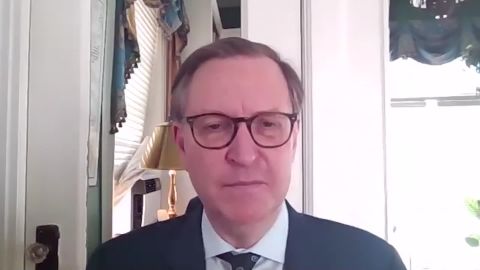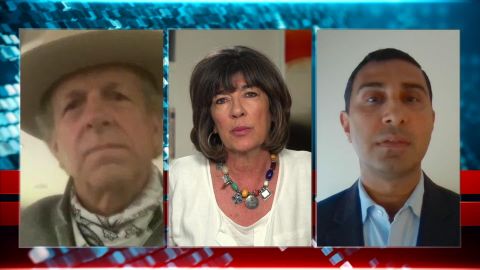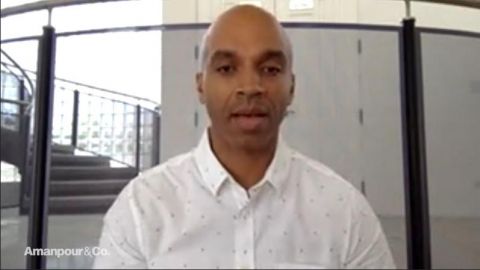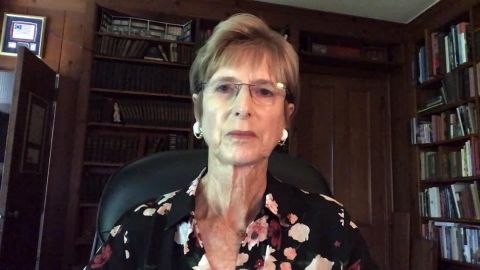Read Transcript EXPAND
CHRISTIANE AMANPOUR: So, the economy, of course, is what voters have on their mind, as some 45 million Americans filed for unemployment since mid-March. So, what does a successful economic recovery plan look like? Our next guest thinks he has the answer, or an answer, anyway. Glenn Hubbard was President George W. Bush’s economic adviser. And he is now a professor of finance and economics at Columbia University Business School, looking at bipartisan solutions to the current crisis. And here is telling our Walter Isaacson what he’s come up with.
(BEGIN VIDEOTAPE)
WALTER ISAACSON: Thank you, Christiane. And, Professor Glenn Hubbard, welcome to the show.
GLENN HUBBARD, DEAN, COLUMBIA BUSINESS SCHOOL: Thank you.
ISAACSON: You just put out a report, two Democrats, two Republicans, from the Aspen Economic Strategy Group, in which you talk about getting people back to work and getting the economy reopened. Why did you produce that report? Was there some dissatisfaction with the way both political parties are handling this?
HUBBARD: Well, I think yes and no, if I can sound too much like an economist in saying that. Yes, in the sense of a huge, big spread between an enormous package suggested by Speaker Pelosi, and some suggestions on the other side would be very little. So we felt the need for that, but also to remind people what this pandemic is about and how reopening happens. And the kind of policies you need for that are very different from what we have done in the past.
ISAACSON: How is the proposals that you all have made, this bipartisan set of proposals, different from the CARES Act and PPP?
HUBBARD: Partly, it’s about flexibility. These proposals involve triggers, depending on how high unemployment is or how bad an economic situation is. So, for example, if you’re optimistic, if you think there’s a V-shaped recovery, the proposals we suggest won’t cost nearly as much as if you think they’re pessimistic. But our view is, our leaders don’t know. We economists don’t know exactly what we’re looking at. We need to be flexible. Second, we would move away from PPP toward more general small business support through lending programs, some of which the Federal Reserve is trying to stand up, and by supporting work with more flexible unemployment insurance benefits, but also doubling the Earned Income Tax Credit during this period really to support low-wage work. We also would provide state and local governments a block grant to help public education, to help their health care systems. State and local governments have had a big revenue hit, just like business, and need that support. Altogether, an optimistic recovery is about a trillion dollars.
ISAACSON: You say you would provide help to state and local governments, aid to them. Does that end up costing a lot of money, or do you think that pays off in the long run?
HUBBARD: Well, it certainly will cost money in the near term. We’re suggesting a $500 billion block grant, which is similar to the proposals from the National Governors Association and others. But we think it’s very effective. The multiplier on stopping the job losses, the output losses of states is very, very high. We have learned that in previous recessions, and we think it’s very important. There’s a political debate on how states may or may not have gotten themselves into trouble for a variety of reasons. But we think you can — you can tailor this approach to avoid that discussion right now, and come back to it later.
ISAACSON: In making these proposals, you’re one of the two Republican members of this report. You worked for George Bush 43. Did you work with the White House in doing this? Or do you find it more useful to work with Republican leaders in Congress?
HUBBARD: Well, I have certainly tried to answer any questions the White House might have and work with them. I think they’re on a similar page. Much of the work I have done personally has been with Republican leaders in the Congress.
ISAACSON: Do you that the White House and the administration have been effective in administering the original PPP program?
HUBBARD: I think there were a number of hiccups in the PPP programs, some of which were from complications, and it’s a tough time. But some of them were rules that just weren’t in the legislation that I think frustrated PPP. I think the Paycheck Protection Program is now off to a much better resolution than it started. But more work needs to be done. I’m focusing my attention the Main Street Lending Facility, which is the new lending version of that. That too is suffering from some hiccups and needs a lot of help.
ISAACSON: What hiccups are they suffering from in helping people on Main Street and the businesses on Main Street?
HUBBARD: Well, I think the programs and its design is trying not to lose money. And in the middle of a financial crisis, lending to small and midsized businesses, you are going to lose money. If you don’t lose money, that means you’re just not setting it up to lend to people who need it. So I think we have to get past that mind-set, that there are a number of changes in the weeds that would make banks more eager to participate and make small businesses more eager to borrow. And I think the Fed is attuned to that. Keep in mind, this is not something the Fed has done before. It was thrown in the Fed’s lap. But if the Fed is going to use a word like Main Street, they need to do it right.
ISAACSON: The Fed has a lot of money still left over, doesn’t it, from the original set of appropriations or budget? Why have they not used it?
HUBBARD: Well, that’s a very good question. They were appropriated $454 billion in the CARES Act to stand up a number of these facilities, one of which is Main Street. And they have been slow to do that. Again, part of it is not wanting to lose the money. But if Congress appropriated that money, they obviously expected there was some risk of loss, or it wouldn’t have done it. The Treasury secretary has signed off, giving the people’s blessing. So I think the Fed needs to pick up its speed a little in getting the Main Street program off the ground.
ISAACSON: So how would you have your new program be different so that it could really help Main Street? Because you have written in “The Wall Street Journal” that Main Street is getting slammed, small businesses are getting slammed, and it’s not being administered correctly to help.
HUBBARD: Well, it’s a very good question. Right now, small business is in a lot of trouble in the reopening phase, and it needs a different kind of help than it did during the shutdown phase. The Main Street program could help by lending to businesses that would have been creditworthy just prior to the onset of COVID-19. That requires banks doing their underwriting, but it also means the banks shouldn’t be punished for every loan that goes bad. Borrowers need a lot of flexibility in the use of the funds. And I think there’s some suggestions that we offer in the report. We’re not trying to be prescriptive, but just things the Fed might want to consider, if it sets up the program and no one comes.
ISAACSON: One of the things in your report was that you want to use loan guarantees done by banks, and that, you said, was so that we really could have a test to say all, are these businesses viable or not? Why did you make that change from the original type of program we had?
HUBBARD: Well, the original program we had, of course, was effectively grants to businesses. As we enter a phase where people are going back to work, really, the question is giving businesses credit to get back on their feet. And we think that the loan guarantee approach will get banks involved and get them involved in their underwriting, but really put the losses mainly on the Treasury if the economy is weak.
ISAACSON: In your report, you also talk about, worry about disincentives to work, that sometimes you can design a program, and it’ll sort of be paying people not to work. How did you try to fix that?
HUBBARD: Well, in the CARES Act, there was a lump sum federal unemployment insurance payment on top of state payments that would have been above the wage of work for many years. So what we suggested was doing it as a percentage replacement, so that that problem does not arise. And particularly during a time where we hope people are going to be going back to work, we’re reopening the economy, the last thing we want to do is a disincentive. So we want to support people going back to work, but not in a way that provides perverse incentives. And we think we have done that. We have also linked it to triggers for each state’s unemployment rate, because this reopening is going to be varied across the country in how easy it is.
ISAACSON: Well, let me get specific. It was about $600 weekly, right, that happened before.
HUBBARD: Correct.
ISAACSON: What are you all doing now?
HUBBARD: It would be a percentage replacement rate that would get people up to about 80 to 90 percent of the average wage, around $400 at most for most people, so smaller, but still a very significant replacement. And, remember, this is on top of the traditional unemployment insurance.
ISAACSON: Would you do things like increase what are called food stamps or those type of programs to make sure that the people really suffering now were — had a better safety net?
HUBBARD: Yes, we did suggest increasing support during this period for the SNAP program that provides food assistance for low-income Americans. We thought there were a number of things in this proposal involving SNAP, involving the Earned Income Tax Credit and other programs that probably are good reforms generally. But we think, in this context, they’re particularly important. One of the things COVID has done is shone a light on the hardships many low Americans face going to work.
ISAACSON: Well, yes, the low-income Americans are the ones who’ve gotten particularly slammed during this.
HUBBARD: Yes.
ISAACSON: And especially African-Americans have been slammed by this, and then the George Floyd protests sort of shattered their faith in our society.
HUBBARD: Yes.
ISAACSON: What are you doing for that type of structural inequality?
HUBBARD: Well, we have advocated a pandemic Earned Income Tax Credit that would double the Earned Income Tax Credit during the period of the pandemic. But, frankly, some of us, as co-authors, have in our own work recommended a big expansion of the Earned Income Tax Credit to childless workers in general. We need to be doing more to support low-wage work in the country. That’s going to be obviously particularly important for some groups in the population. But, frankly, if people aren’t on the ladder of work, they can’t move up. As a society, if we believe in opportunity, we really need to do. And the rate of return on that investment is very, very high.
ISAACSON: Give me some examples from your own work of how you try to focus on getting people to be able to move up the economic ladder.
HUBBARD: Well, I think there are a couple of things. Let’s talk about preparation and the work itself. In terms of preparation, the unsung heroes in the country here are community colleges. And yet community colleges have had their funding cut in many states for a very long time. Part of what we’re doing in this proposal is offering a block grant of support to community colleges and public universities to restore that. There are some people who talk about — quote — “free college,” but that doesn’t provide the money to the states to stand up the community college. So, I think that’s an empty promise. A better promise is to say, let’s support what community colleges are trying to do for training. Then, once people work, let’s support low-wage work. So the thesis of the Earned Income Tax Credit, of course, is that, if I’m working, I get extra support that makes my reward to work higher than its private market value. That’s what the EITC, Earned Income Tax Credit, does. It needs to be more generous. And it needs to support childless workers who are young people just starting out. So, I think, if we focus on preparation, and we focus on work support, we will have done a lot of good, not just in the pandemic, but in our economy in general.
ISAACSON: This is all going to cost a lot of money. I know, in your report, you say the money can — is a wide range, depending on how fast the recovery comes and how fast we defeat the coronavirus. But how are we going to afford these things? Are you worried now about the deficit that we’re racking up?
HUBBARD: Of course I’m worried that. But I begin by always asking myself, what’s the counterfactual? Doing nothing isn’t feasible. The economic loss that we would face without these interventions is very large. That’s why we wrote the report. So, a trillion dollars is a lot of money. And it could even be $2 trillion, if the recovery is weaker. But it would be harder still for the government if we did nothing. This is like a war. And in a war, one borrows a lot of money and then pays it back later. There will be a day of reckoning. We will have to have a discussion of fiscal reform, of taxes, of spending to pay for this, and a number of government promises. But in the middle of the war, the goal should be to win it.
ISAACSON: The president just floated the idea of another stimulus check, just sending out another check to people. That’s not in your proposal. What do you think of that? And do you think there are better ways to be doing this?
HUBBARD: Well, I could certainly make an argument for doing that, depending on the shape of the recovery. But we felt that our proposal that we were focused on the reopening, and in a reopening world, there will be opportunities for people to go back to work. And so what we want to do is support that and, for people who aren’t as fortunate to be back to work quickly, support them through the unemployment insurance system, through short-term compensation and other programs.
ISAACSON: Unemployment is now up at 14 percent. There’s some people who just may never get their jobs back. What do you do for them?
HUBBARD: Well, the recovery is going to be slow for employment. If you look at the Congressional Budget Office’s forecast, even a year from now, we could be at 9 percent, plus unemployment. So we will need cyclical support for people for quite a while. But the deeper part of your question is, how do we prepare people whose jobs just may not come back or who may need to retrain for something else? And I think that’s really about support to attend community colleges or other institutions that focus on that, and then support for reentry into work, expansions of the Earned Income Tax Credit and programs like that. Those issues were, of course, present before COVID. But I think COVID has accentuated them.
ISAACSON: There’s been a spike in cases, especially in places like Florida that reopened. Are you worried that businesses are going to have to re-close, close down again? And can we close the economy again?
HUBBARD: Well, I think businesses are very worried about that, which is why there’s such an emphasis on safety. Many employers long after regulation says they can do something are likely to move much slower as a result. So, I think, irrespective of what regulation allows, employers are going to go slowly until they figure this out. To completely re-shut the economy again would be an economic calamity. We really need to avoid that. And the way to avoid that is by being careful and measured and reasonable in the reopening.
ISAACSON: We sometimes say, especially down here in New Orleans, when we have a hurricane, that a crisis shouldn’t be wasted. What type of structural changes would you do to America and its economy and its work force coming out of this pandemic?
HUBBARD: Well, part of it is about preparing people and supporting work. I think that was a problem long before COVID-19. But COVID-19 really shone a light on how unequal that preparation is and how unequal that support is. I think it’s time for that kind of structural reform. And it’s also time to reform the way we think about labor market policies generally. Programs like unemployment insurance were designed in the 1930s for losing your job for a short period of time and then getting it right back, when we know, for years, that many of the transitions in the labor market are much more structural, and we need a different way of dealing with them. Hopefully, one of the side effects, if you will, of COVID might be shining a light on the need for those kinds of policies.
ISAACSON: Professor Glenn Hubbard, thank you for joining us tonight on the show.
HUBBARD: My pleasure. Thank you.
About This Episode EXPAND
Christine Todd Whitman, former governor of New Jersey, discusses the climate crisis and the upcoming presidential election. Faiz Shakir and Mark McKinnon analyze interesting trends from last night’s Democratic primaries. Columbia economist Glenn Hubbard explains what a successful economic recovery must look like. Artist Kadir Nelson explains the inspiration behind his pieces.
LEARN MORE



